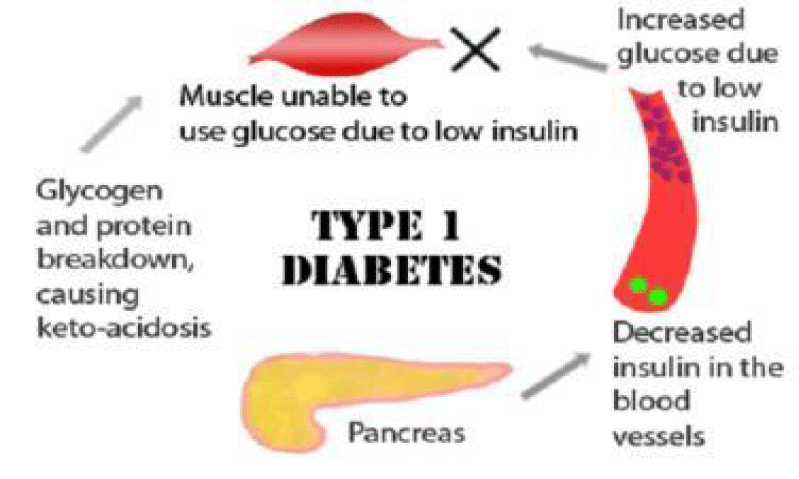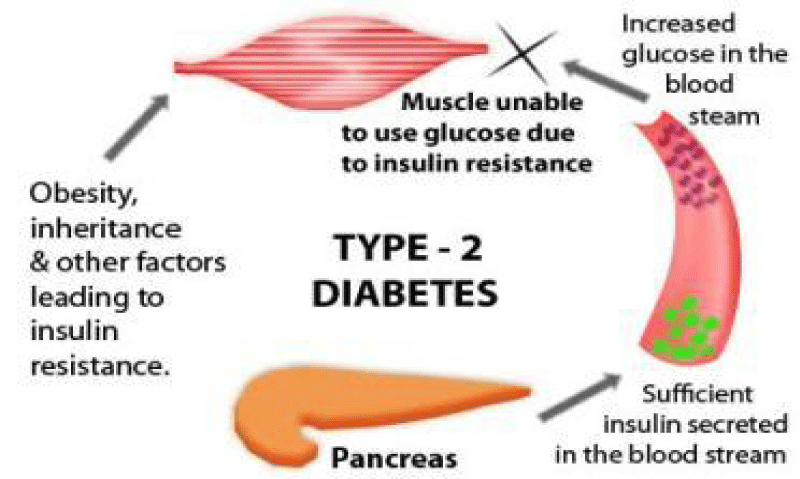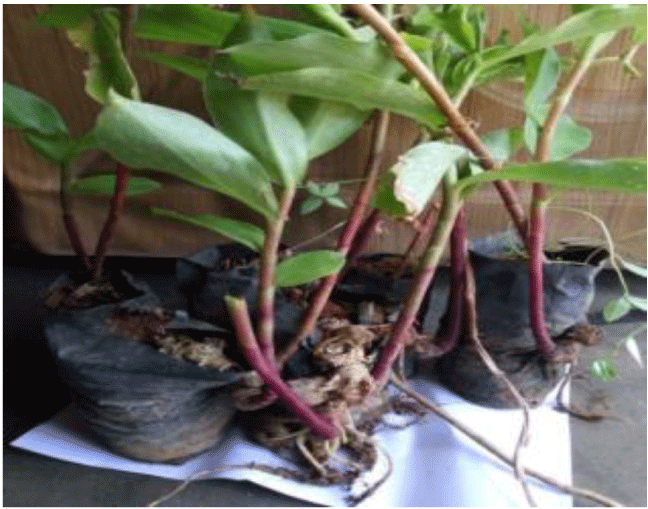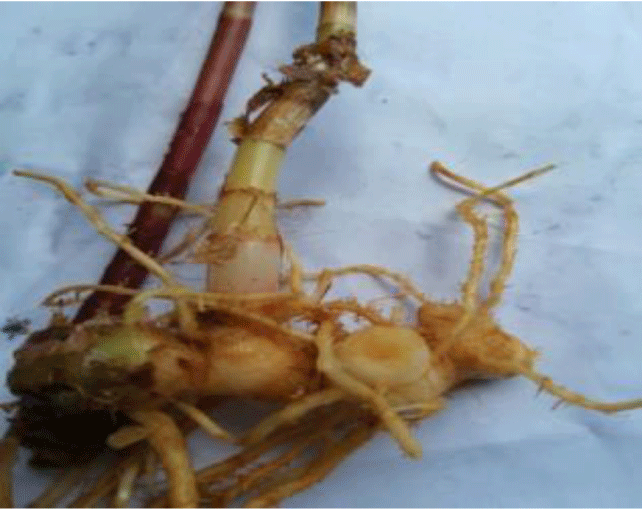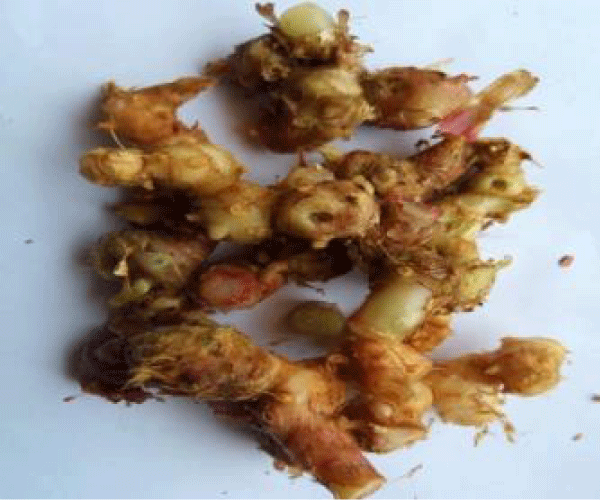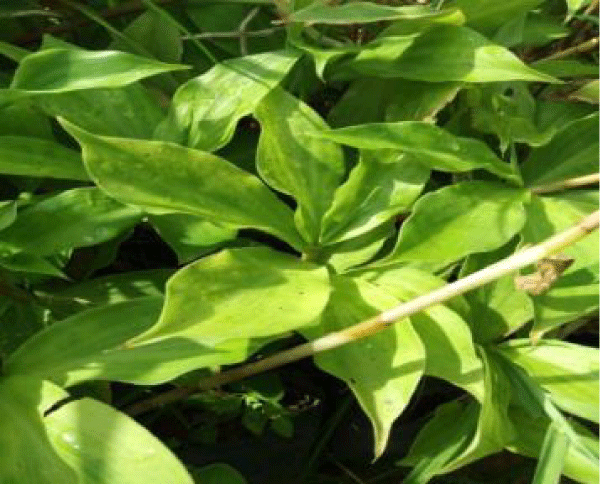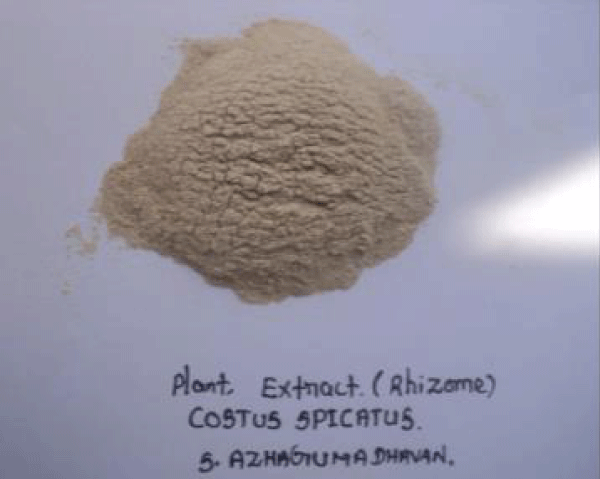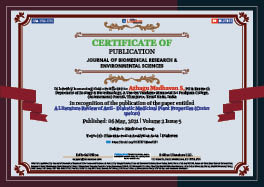> Medicine Group. 2021 May 06;2(5):305-310. doi: 10.37871/jbres1231.
A Literature Review of Anti- Diabetic Medicinal Plant Properties (Costus speices)
Azhagu Madhavan S*, Ganesan S, Sripriya R and Priyadharshini R
- Insulin plant
- Diabetes
- Cancer prevention agent
- Pharmacological movement
Abstract
Costus species is a significant restorative and decorative plant used to fix various illnesses. In India 6,000 plants are used for traditional and herbal medicine. The plant Costus spicatus commonly known as ‘Spiral ginger’ as ‘insulin plant’, a wonder drug down blood sugar level and hypoglycemic properties. The plant has been found to have numerous pharmacological exercises, for example, antibacterial, antifungal, anticholineesterase, cancer prevention agent, antihyperglycemic, calming, pain relieving, antipyretic, antidiuretic, antistress and estrogenic action. The rhizomes of Costus species are harsh, astringent, bitter, cooling, love potion, laxative, anthelminthic, depurative, febrifuge, expectorant, tonic, improve assimilation, and is an energizer herb that clears poisons. It additionally has against richness, anabolic properties. This audit plainly demonstrates the need to perform logical investigations with therapeutic vegetation featuring potential for Costus species because of its antidiabetic, pharmacological and cell reinforcement properties. The rhizome is credited with purgative and tonic properties. India is a botanical garden of the world for natural resources.
Introduction
The number of people living with diabetes in urban areas is expected to increase to 472, 6 million in 2045 mainly due to global urbanization, according to the latest 2017 data from the Indian Diabetes Federation (IDF). Diabetes mellitus is a constant ailment which causes a great many passings worldwide every year because of the related difficulties IDF [1]. Diabetes is a metabolic issue described by hindered glucose use and is theunderlying factor for both hypoglycaemia and hyperglycaemia. Constant hyperglycaemia brings about debilitated capacity or disappointment of different organs, particularly the eyes, kidneys, nerves, heart and veins. In spite of advances in medication, diabetes as a significant wellbeing intricacy is by all accounts developing at analarming extent world over and in India, specifically. Before the finish of 2030, 79.4 million Indians are required to be influenced by this metabolic issue and this records for almost one-6th of the world’s diabetics [2]. Glycation continues over some undefined time frame which prompts the creation of Advance Glycation Final Results (AGEs). AGEs cause irreversible auxiliary and utilitarian harm to the influenced particles. Helpful operators utilized for diabetes, focus to cut down the blood glucose fixations as close as to typical physiological levels. Some antidiabetic drugs target key proteins hydrolyzing the starches, for example, α-amylase and α-glucosidase so as to diminish thepost-prandial height of blood glucose [3,4]. A few examinations have demonstrated the hypoglycaemic impacts of Costus sp rhizome in alloxan or streptozotocin in-duced diabetic rodents [5-8]. Almost 100 polysaccharides from plants have been accounted for to have hypoglycemic Activity. Costus speciosusisa winding, crepe or wild ginger has a place with the family costaceae. It is a significant wellspring of diosogenin and is utilized in numerous human and vetinary meds. It is severe, astringent, cooling, stomach related, energizer and useful for the heart. It fixes kapha and pitta issue, dyspepsia, fever, hack and other respiratory maladies, diabetes, edema, blood illnesses, uncleanliness, and other skin sicknesses. A fluid concentrate of C. speciosus rhizome part demonstrated critical hypoglycemic impacts when it was regulated orally with a synchronous glucose load [9].
Type 1 diabetes
(Due to autoimmune β-cell destruction, usually leading to absolute insulin deficiency) (Figure 1).
Type 2 diabetes
(Due to a progressive loss of β-cell insulin secretion frequently on the background of insulin resistance) (Figure 2).
Gestational diabetes mellitus
It occurs during pregnancy without a previous history of diabetes develop a high blood sugar level. They have an increased risk of developing type 2 diabetes after pregnancy (Figure 3).
Antidiabetic activities
The utilization of restorative plants depends on family convention and turned out to be wide spread in people medication of a few created or creating nations. These plants have been utilized as an elective treatment for different ailments, including Diabetes Mellitus (DM) [10]. DM is a metabolic issue of different etiology described by constant hyperglycemia resultant or insufficiency in insulin discharge by pancreatic beta cells, as happens in type DM 1, orinsulin activity or both, as happens in type 2 DM. Type 2 Diabetes Mellitus (T2DM) is an interminable and dynamic sick ness that especially focuses on the Hispanic populace in the United States. As indicated by the Center for Disease Control and Prevention (CDCP) in 2005, Hispanic grown-ups had diabetes pervasiveness rates 1.7 occasions that of non-Hispanic whites [11]. In a cross-sectional clinical examination, patients expending possibly one new leaf or 1 teaspoon of shade-dried powder/day of C. igneus related to different modalities of treatment had adequately delivered glycemic control in diabetics [12]. An examination assessed the capacity of a tea produced using the leaves of Intraperitoneal (IP) insulin resilience testing after the 10-week study period indicated that C. spicatus tea utilization didn’t adjust insulin affectability, which recommended that at the portion given, tea produced using C. spicatus leaves had no adequacy in the treatment of corpulence actuated hyperglycemia [13]. The enormous scope development of C. pictusin different pieces of India may give a home grown cure easily to the individuals influenced with diabetes. It is extremely fundamental to develop C. pictusin different pieces of India to mitigate the intricacies of diabetes by advancing its marvelous impact. Be that as it may, before suggesting for huge scope development, the multi area field preliminaries for phytochemical constituents are fundamental [14]. Conventional therapeutic plants are utilized all through the world for the treatment of Diabetes mellitus, in light of the fact that the plants are viewed as less poisonous, minimal effort and liberated from reactions than the engineered meds. The vast majority of the restorative plants are adequately approved for their helpful proficiency [15]. In this way examination of medications from conventional therapeutic plants has gotten progressively significant. A few such herbs have indicated antidiabetic movement when surveyed utilizing by and by accessible trial procedures. Among these Diabetes mellitus, has caused to notice its development in the quantity of events. There are alsoconsequences as 1 million removals, 500 000 casesof kidney illness, 300000 visual deficiency, 285 millionpeople worldwide with diabetes, and by 2030 will be 435 million diabetics for the most part in creating nations [16]. There is a gauge that these issues identified with that malady create yearly spending of $150 billion. Diabetes mellitus brokenness is perceived as a heterogeneous gathering of disarranges with the regular components of hyperglycemia and glucose bigotry and is brought about by an inadequacy of creation and oraction of insulin, which prompts intense indications andchronic intricacies attributes. This issue including the digestion of glucose, fats and proteins,and has genuine results both when emerges as when quickly settles gradually. These days it comprises a general medical issue by the quantity of individuals who have the malady. Diabetes mellitus is arranged basedon clinical introduction of the ailment etiology and in three sorts; Type I diabetes, Type II diabetes, and gestational diabetes [17]. The variety has a place with Costus family. They are lasting tropical plants. They are regularly recognized from plants of the class Zingiber the spiraling development of their stems. Other than the Costus spicatus we can make reference to the Costus pulverulents and Costus speciosus who as of now have a few properties of pharmacological intrigue portrayed. Costus pulverulentus (Costaceae), a species endemic to Mexico, is utilized for the observational treatment of disease, agony, and irritation [18]. Type II diabetes is portrayed by insulin opposition and relative insulin inadequacy. The determination of Type II diabetes as a rule happens after the age of 40 years, however may happen prior, particularly in populaces with high predominance of diabetes. There are reports of expanded of youngsters creating Type II diabetes. Type II diabetes can stay undetected or are asymptomatic for a long time and conclusion is regularly happens after confusions related by assessment of glucose levels in blood or pee. It is frequently, however not generally, related with stoutness, which thus may cause insulin obstruction and lead to raised degrees of blood glucose [19]. Hyperglycemia is expanded glucose levels in the blood. The primary driver of hyperglycemia is diabetes happening because of pancreatic brokenness because of the nonappearance, diminished or insufficient activity of insulin, the hormone answerable for the upkeep of glucose levels in blood (under 110 mg/dL and fasting to 140 mg/dL when estimated blood glucose 2 hours after dinners).
Results and Discussion
Pharmacological activities
Costus speciosus (crepe ginger, family Costaceae) is a decorative plant utilized in customary medication for the treatment of aggravation, stiffness, bronchitisfever, cerebral pain, asthma, tooting, obstruction, helminthiasis, infection, skin ailments, hiccough, frailty, just as consuming sensation on pee [20]. Ethnopharmacology meets these targets, since its fundamental reason in phytochemical and pharmacological investigations to accommodate the data procured from the neighborhood networks that utilize restorative vegetation so as to give information to research of moderate drugs to total populace, particularly in creating nations [21]. A large portion of the plants have been found to contain substance like glycosides, alkaloids, terpenoids, flanoidsetc, that are much of the time involved as having on the particular method of activity of these plants medication or home grown detailing utilized for treating diabetes. The ethnobotanical data reports express that around 800 plants may process antidiabetic potential.
The Ministry of Health gave in February 2009, the National Relationship Medicinal Plants of Interest to the SUS (RENISUS). This rundown incorporates plantsmedicines that can possibly create results important to SUS. The rundown see was and is coordinating investigations and research that could sponsor the upkeep of home grown proportion accessible for use by the populace, with wellbeing and adequacy for the treatment of certain sicknesses [22]. Ethnobotanical contemplates are significant for the most part in Brazil, since its domain is home to perhaps the most extravagant verdure ofthe globe, of which 99.6% are synthetically obscure andalso one of the biggest social decent varieties. The utilization of restorative herbs in the treatment of different infections happens for a huge number of years. Antiquated developments definitely knew the restorative intensity of certain plants and developed, passing the information to each age. Throughout the years and the coming of medication, this information has gotten debased by wellbeing experts, who have started to concentrate on allopathic treatment. In any case, today, science and wellbeing strategies are trying to reestablish the utilization of therapeutic plants by the populace. Therapeutic plants include a rich wellspring of dynamic intensifies that can kill snake venoms or poisons. The Costus family has a wide well known use for various pieces of the American mainland. Costus speciosusis a significant therapeutic plant generally utilized in a few indigenous restorative details. Costus spicatusis utilized by the Amazonian populace to treat aggravation, torment and other neurotic manifestations.Costus pulverulentus C. presl (Costaceae), a species endemic to Mexico, is utilized for the experimental treatment of malignancy, torment, and irritation. Diabetes mellitus brokenness is perceived as a heterogeneous gathering of scatters with the regular components of hyperglycaemia and glucose prejudice, is brought about by insufficiency of creation and/or activity of insulin, which prompts intense indications and interminable intricacies qualities. This issue including the digestion of glucose, fats and proteins and have genuine outcomes, both when it shows up as when rapidlysettles gradually. These days it comprises a general medical issue by the quantity of individuals who have the ailment. Diabetes mellitus is characterized dependent on the etiology, clinical introduction of illness in three sorts; Type I diabetes, Type II diabetes, and gestational diabetes [23] (Figures 4-8).
Diabetes is straightforwardly identified with the working of the pancreas. Single blended organ of the human body, 98% exocrine (creating pancreatic juice) and 2% endocrine segment are spoken to by four cell types: type alpha cells, beta cell type, delta type cells and cells type F. The leaves and rhizomes of Costus species are accounted for as antidiabetic in nature and are utilized in the treatment of diabetes mellitus. The epidemologic considers and clinical preliminaries expresses that hyperglycemia is the primary driver of complexities, for example, coronary course sickness, cerebrovascular infection, renal disappointment, visual deficiency, neurological inconveniences and sudden passing. The cancer prevention agent exercises of leaves and rhizomes in methanol, watery, ethanol, and ethyl acetic acid derivation removes were evaluated utilizing various models like DPPH, β-carotene, Deoxyribose, superoxide anion, diminishing force, and metal chelating examine at various focuses. Leaves and rhizomes of C. pictus demonstrated great cancer prevention agent action of about 89.5% and 90.0% when contrasted and standard BHT (Butylated Hydroxy Toulene) (85%) at a centralization of 400 μg/ml. Results got uncovered that methanolic concentrates of the two leaves and rhizomes of C. pictus have higher cancer prevention agent action when contrasted and different concentrates. In another investigation, methanolic leaf concentrate of C. pictus D. Wear caused noteworthy increment in superoxide dismutase, catalase, glutathione peroxidase, glutathione reductase, nutrient A, nutrient C, nutrient E and diminished glutathione, and consequently, could be successful in decreasing oxidative pressure and free radical-intervened infections. The cell reinforcement property of this plant might be because of the nearness of phenolic substances [24].
Antioxidant activity
Recommended that advanced ways of life delay every day exercises into the evening, upsetting circadian rhythms, which may cause rest unsettling influences. Rest aggravations have been ensnared in the dysregulation of blood glucose levels and answered to build the danger of Type 2Diabetes (T2D) and diabetic intricacies. Rest issue are dealt with utilizing hostile to a sleeping disorder tranquilizes that target ionotropic and G Protein-Coupled Receptors (GPCRs), including γ-Aminobutyric Corrosive (GABA) agonists, melatonin agonists, and orexin receptor opponents. A more profound comprehension of the impacts of these drugs on glucose digestion and their fundamental systems of activity is critical for the treatment of diabetic patients with rest issue. Brazil, it is accepted cap ¼ of the eight billion pharmaceutical industry national salary emerging in 1996 were gotten from restorative plants. Be that as it may, little data is accessible about the potential danger of certain restorative plants for human wellbeing, albeit many contain synthetic substances known to be mutagenic and/or cancer-causing. Other than the ease, they are found in incredible assortment in our nation local species that are utilized exactly for centuries [25]. Natural products are subtle, not conspicuous, under 0.5 inch, and green-shaded. Costus species are perpetual rhizomatous herbs with erect or spreading stems. Leaves are basic, smooth, tireless, spirally masterminded around the storage compartment. The leaves are sub sessile and seem dim green in shading, elliptic or obovate fit as a fiddle. Leaves are basic, exchange, whole, oval, evergreen, 4-8 creeps long with equal venation. There is some variety in various types of Costus like bloom shading and surface of the leaves. In the event of C. igneus, the leaves have light purple under side while C.speciosus had smooth surface underneath. The inflorescence is a spike around 10 cms in length with enormous bracts in sub terminal position. Bracts are praise or mucronate framing a cone like structure. In C. pictus, bracts are green with yellow shaded bloom with red stripes. C.igneus, bracts are green in shading with orange blossoms. In C. speciosus, bracts are brilliant red shaded with white blossoms having cup-shape labellum and peak yellow stamens. Organic product is a container ellipsoidal fit as a fiddle. Seeds are dark, five in number with a white plump aril. Numerous types of the family Alpinia, Amomum, Curcuma, Costus, Caempferia and Zingiber are available in generally arranged tonics and fixings called ‘mixtures’, which are industrially accessible. It is prominently utilized for its filtering and diuretic activity, for alleviation of urinary contaminations and to oust kidney stones. Additionally for treating colds, sore throat, looseness of the bowels, the runs and treatment of diabetes.
Summary and Conclusion
Anti-diabetic agents from medicinal plant
Phytochemical investigation of rhizomes Costus spicatus uncovered the nearness of flavonoids, flavo-sugars, saponins and sapogenins. The antimicrobial activity, mitigating and diuretic exercises additionally demonstrated. In any case, his hipogliceminante impact was not considered. The point of this investigation is to lead an audit of the clinical and toxicological properties of the plant Costus spicatus which is in the National List of Medicinal Plants of Interest to the SUS (Renisus) [26]. Their utilization in conventional medication incorporates the utilization of leaves, stems and rhizomes as a diuretic and tonic. The cancer prevention agent activity of species Costus isn’t yet surely known. In any case, contemplates show that numerous types of Zinziberaceae can sequester free radicals. The Oxygen Species (ROS) are atoms with an unpaired electron in the last orbital creation them exceptionally flimsy, very responsive, and colossal ability to consolidate with different individuals particles of the cell structure, for example, DNA, proteins, starches and lipids. Substance investigations of the airborne pieces of Costus spicatus permitted the detachment of new flavonoid diglycosides, for example, tamarixetin 3-O-neohesperidoside the Kaempferol 3-O-neohesperidosidesix flavonoids and different mixes, for example, 3-O-neohesperidosídeo quercetin. Phytochemicals are the synthetic compounds removed from plants. These natural synthetic substances are named essential or optional constituents, contingent upon their job in plant digestion. Essential constituents incorporate the basic sugars, aminoacids, proteins, purines and pyrimidines of nucleic acids, chlrophyll’s and so on. Optional constituents are the rest of the plant synthetic substances, for example, alkaloids (got from aminoacids), terpenes (a gathering of lipids) and phenolics (got from sugars).
Natural products and treatment of diabetes
Natural products and its derived active compounds could also be possible alternatives for the treatment of kind two polygenic disorder and its complications with none adverse effects. There square measure a large variety of active healthful plants and its natural bioactive molecules that have already reportable the therapeutic nature against polygenic disorder. Several medicinal plants have been used since ancient times to manage and prevent diabetes and associated conditions [26]. The efficiencies of conventional and non-conventional extraction methods mostly depend on the critical input parameters. Plant creates these synthetic concoctions to secure itself however ongoing exploration shows that stresses the plant wellspring of a large portion of these defensive, ailment forestalling mixes. A genuine healthful job for phytochemicals is turning out to be increasingly plausible consistently as research reveals a greater amount of their noteworthy advantages. Inside 10 years, there were various emotional advances in diagnostic procedures including TLC, UV, NMR and GC-MS that were incredible assets for partition recognizable proof and structure assurance of phytochemicals. The ethno-herbal data reports that around 800 plants have against diabeticpotential. The blossoms show up in pre-fall or late-summer. The blossoms seem as though crepe paper, hence regularly called crepe ginger. After the blossoms blur away, the alluring cone-molded bracts remain. For the most part, the stems sprout during the long stretch of April and blooming begins during July and proceeds till the finish of September. The blossoms mature during center of the November after which the leaves shed off and larger part of stems begin evaporating [26]. The underground parts (rhizomes) stay lethargic from December to March or even April. It is a lasting, upstanding, spreading plant coming to around two feet tall, with the tallest stems falling over and lying on the ground. Leaves are basic, substitute, whole, elliptical, evergreen, 4-8 crawls long with equal venation. The huge, smooth, dull green leaves of this tropical evergreen have light purple undersides and are spirally organized around stems, shaping alluring, angling clusters emerging from underground rootstocks. Lovely, 1.5-inch distance across, orange blossoms are delivered in the warm months, showing up on cone-like heads at the tips of branches.
Acknowledgement
The author is also very grateful to the Secretary and Correspondent and the Principal of A.V.V.M. Sri Pushpam College (Autonomous), Poondi-613 503, Thanjavur (Dt), for providing the excellent infrastructure and necessary facilities to carry out my research work successfully.
References
- International Diabetes Federation IDF Diabetes Atlas. 6th ed. Brussels, Belgium: International Diabetes Federation. 2013. http://www.idf.org/diabetesatlas.
- Madhavan S, Ganesan S. Phytochemicals analysis of anti-diabetic effect of costus spicatus in streptozotocin-induced diabetic albino wistar male rats. European journal of research development and sustainability. 2021;2(2). https://tinyurl.com/3dnztr94
- Mahomoodally MF, Subratty AH, Fakim A, Choudhary MI, Khan S. Traditional medicinal herbs and food plants have the potential to inhibit key carbohydrate hydrolysing enzymes in vitro and reduce postprandial blood glucose peaks in vivo. ScientificWorldJournal. 2012;2012:285284. doi: 10.1100/2012/285284. Epub 2012 Feb 20. PMID: 22654584; PMCID: PMC3361172.
- Madhavan S, Mahadevi M, Ganesan S, Vinotha P, Uma V. Phytochemicals screening of physico-chemical parameters and fluorescence analysis of plant ethanolic leaf extract costus pictus. Asian Journal of Advances in Medical Science. 2021;2(4):24-30. https://tinyurl.com/rps9tmbm
- Revathy J, Abdullah SS, Kumar PS. Antidiabetic effect of costus speciosus rhizome extract in alloxan induced albino rats. Journal of Chemistry and Biochemistry. 2014;2(1):13-22. https://tinyurl.com/42faazex
- Ali HA, Almaghrabi OA, Afifi ME. Molecular mechanisms of anti-hyperglycemic effects of costus speciosus extract in streptozotocin-induced diabetic rats. Saudi Medical Journal. 2014;35(12):1501-1506. https://tinyurl.com/4pxu5pnm
- Madhavan, Sivalingam, Sivamani, Pandiyan. Title of book Introduction on diabetes mellitus. Publisher: scholars press is a trademark of international book market service ltd., Mauritius, member scriptum publishing group. 2021. ISBN: 978-613-8-92491-3.
- Bavarva JH, Narasimhacharya AV. Antihyperglycemic and hypolipidemic effects of costus speciosus in alloxan induced diabetic rats. Phytother Res. 2008 May;22(5):620-626. doi: 10.1002/ptr.2302. PMID: 18444247.
- Madhavan S, Senthilkumar S, Padma M, Sasikala P, Jayaseelan T, Ganesan S. A study on establishment of phytochemical analysis of quality parameters and fluorescence analysis of costus spicatus- rhizome extract medicinal plants a well-known tropical folklore medicine. Journal of Drug Delivery and Therapeutics. 2019;9(1-5):240-243. https://tinyurl.com/yhjw5779
- Elisabetsky K. E. pesquisasem plantas medicinais. Ciência e Cultura. 1987;39:697-702.
- Centers for Disease Control and Prevention. Data and trends. 2008. www.cdc.gov.
- Shetty AJ, Choudhury D, Rejeesh, Nair V, Kuruvilla M, Kotian S. Effect of the insulin plant (Costus igneus) leaves on dexamethasone-induced hyperglycemia. Int J Ayurveda Res. 2010;1(2):100-102. doi: 10.4103/0974-7788.64396. PMID: 20814523; PMCID: PMC2924971.
- Madhavan S, Vinotha P, Uma V. Pharmacological and anti-Cancer activity of Ipomoea sepiaria Methanolic extract against PC-3 cell Line. Asian Journal of Advances in Medical Science. 2020;2(3):26-32. https://tinyurl.com/va45du8e
- IDF. International Diabetes Federation-IDF. DiabetesAtlas-4th Edition. 2009.
- Guyton S. The treaty of medical physiology guyton & hall. Publisher ELSEVIER Physiology. 12th Edition-Elsevier/National Medicine. IDF, International Diabetes Federation-IDF DiabetesAtlas-4th Edition. 2009.
- Madhavan S, Senthilkumar S, Andrews S, Ganesan S. Anti-diabetic effect of ethanol extract of costus spicatus jacq. In rhizome extract in streptozotocin-induced diabetic rats –histological study.Journal of Drug Delivery and Therapeutics. 2019;9(4-s):483-487. https://tinyurl.com/2yehhs9r
- Madhavan S, Arjun P, Moorthi P, Ganesan S. Antidiabetic and hypolipidamic effects of costus spicatus JACQ. rhizome extract against streptozotocin induced diabetic albino rats. World Journal of Pharmaceutical Research. 2017;6(14):806-816. https://tinyurl.com/42cx27rr
- Attas AA, Shaer NS, Mohamed GA, Ibrahim SR, Esmat. Anti-inflammatory sesquiterpenes from costus speciosus rhizomes. J Ethnopharmacol. 2015;24:365-367. https://tinyurl.com/2yehhs9r
- Senthilkumar S, Madhavan S, Andrews S, Ganesan S. A study on phytochemicals screening of physico-chemical parameters and fluorescence analysis of insulin medicinal plants costus spicatus- Jacq. Journal of Drug Delivery and Therapeutics. 2019;9:478-482. https://tinyurl.com/yvvht2a2
- Madhavan S, Moorthi P, Kavitha P, Ganesan S. Hepatoprotective and antidiabetic effect of aqueous effects of Costus spicatus JACQ. Rhizome extract in streptozotocin induced diabetic rats – histological study. International Journal of Life Sciences. 2018;11:61-66. https://tinyurl.com/4vez34hw
- kumar S, Madhavan S, Ganesan S. Evaluation of in vivo anti-diabetic activity of ethanolic extract of flower of costus spicatus (costaceae). Journal of the Asiatic Society of Bengal. 2021;23(1).
- Nascimento C, Azevedo LC, Camacho AF, Oliveira F, Gomes ML. Analysis of hypoglycemic effect of an aqueous extract of Costus spicatus on F1 mice subjected to hyperglycaemic diet. International Journal of Advanced Research in Biological Sciences. 2016a;3(2):99-107. https://tinyurl.com/2mua3haz
- Badke MR, Budó ML, Alvim NA, Zanetti GD, Heisler EV. Popular knowledge and practices regarding healthcare using medicinal plants. Text context nursing, Florianópolis. 2012;21(2):363-370. https://tinyurl.com/59px9skm
- Madhavan S, Senthilkumar S, Ganesan S. Histopathological assessment of the kidney of stz induced diabetic rats treated with macerated costus spicatus jacq. Rhizomes Extract. International Journal of Pharmaceutics & Drug Analysis. 2018;6(2):203-209. https://tinyurl.com/5x95rxcs
- Padma M, Ganesan S, Jayaseelan T, Madhavan S, Sasikala P, Senthilkumar S, Mani P. Phyotochemical screening and GC-MS analysis of bioactive compounds present in ethanolic leaves extract of silybum marianum (L). Journal of Drug Delivery and Therapeutics. 2019;9(1):85-89. https://tinyurl.com/48up98k5
- Madhavan S, Mahadevi M, Vinotha P, Uma V. Anti – hyperglycemia activity of aloe vera ethanolic extract against Mouse 3t3-L1 adipocyte cell line. International Journal of Applied Chemical and Biological Sciences. 2020;1(3):58-66. https://tinyurl.com/c6rkzvwt
Content Alerts
SignUp to our
Content alerts.
 This work is licensed under a Creative Commons Attribution 4.0 International License.
This work is licensed under a Creative Commons Attribution 4.0 International License.





